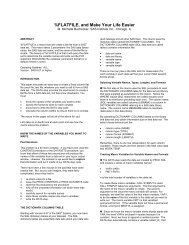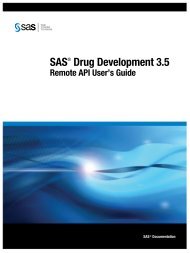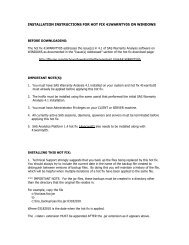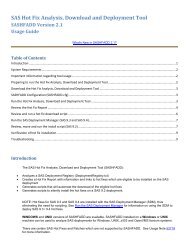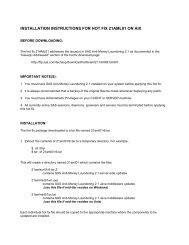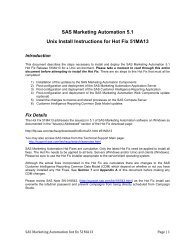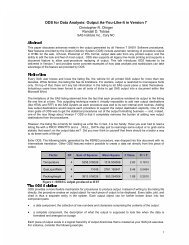SAS 9.3 Web Applications: Clustering - Index of - SAS
SAS 9.3 Web Applications: Clustering - Index of - SAS
SAS 9.3 Web Applications: Clustering - Index of - SAS
You also want an ePaper? Increase the reach of your titles
YUMPU automatically turns print PDFs into web optimized ePapers that Google loves.
configuration tasks. As a result <strong>of</strong> the cell-level scope provided by <strong>Web</strong>Sphere<br />
Application Server, each <strong>of</strong> the JMS resources are deployed to the cell.<br />
Strategies for Overcoming Limitations<br />
Deploy a Stand-alone <strong>Web</strong> Application Server<br />
The Event Generation Framework cannot be clustered. The packaging <strong>of</strong> Event<br />
Generation Framework within the same EAR file that is used for <strong>SAS</strong> BI Dashboard<br />
presents a challenge for sites that intend to cluster <strong>SAS</strong> BI Dashboard. The strategy<br />
that is described in the detailed steps in the sections that follow is to deploy a standalone<br />
<strong>Web</strong> application server and to deploy the Event Generation Framework <strong>Web</strong><br />
application to it.<br />
Hot and Cold Standby Strategy<br />
This strategy can be used to meet high availability requirements. The strategy is to<br />
configure two machines, each with a stand-alone <strong>Web</strong> application server and the<br />
<strong>SAS</strong> BI Dashboard Event Generator <strong>Web</strong> application. One <strong>Web</strong> application server is<br />
active on the hot machine, and the other <strong>Web</strong> application server is inactive on the<br />
cold standby machine.<br />
High Availability S<strong>of</strong>tware Strategy<br />
Another alternative for ensuring high availability is to use high availability s<strong>of</strong>tware<br />
such as IBM PowerHA SystemMirror, Oracle Solaris Cluster, HP Serviceguard, and<br />
Veritas Cluster Server by Symantec. Most <strong>of</strong> these products provide virtual<br />
networking and replicated data storage. In this case, a virtual IP address is shared<br />
by two machines and the high availability s<strong>of</strong>tware detects a failure and manages the<br />
transition <strong>of</strong> activity from the failed machine to the standby machine. The following<br />
list identifies the high-level steps that the high availability s<strong>of</strong>tware takes:<br />
1 Cleans up the process on the failed machine.<br />
2 Releases disk resources.<br />
3 Shuts down the network interface to which the virtual IP address is bound.<br />
4 Mounts the disks on the standby machine.<br />
5 Checks the disk.<br />
<strong>SAS</strong> Middle-Tier Limitations 3<br />
6 Starts the network interface to which the virtual IP address is bound.<br />
7 Starts the <strong>Web</strong> application server and the <strong>SAS</strong> <strong>Web</strong> applications that are<br />
deployed on it.





